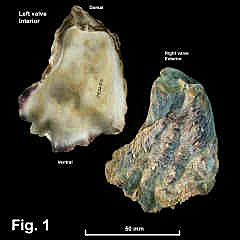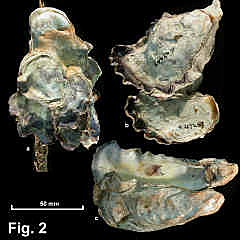|
|
OSTREIDAE |
|
|
|
Saccostrea glomerata (A. Gould, 1850) Sydney Rock Oyster Description: Shell solid, heavy. Shape variable from roughly circular to elongate, Lower (left) valve cup shaped, adherent to substrate and conforming to the surface, upper (right) valve nearly flat. Hinge line short, straight. Interior white, single adductor muscle scar well defined, valves with chomata inside margin (Fig. 2c). Exterior with irregular, coarse radial ribs, surface crumpled. Shell colour dark purple to black. Size: Up to about 100 mm in height. Distribution: Southeastern Australia and North Island of New Zealand. In Australia, specimens of confirmed identification are known from Shoalwater Bay, Qld, southwards to Wilsons Promontory, Vic and the Furneaux Group in Bass Strait. It is farmed in Qld and NSW from native stock and in the Albany area of south-western WA from introduced stock. Reports of this species from northern Australia are incorrect as they relate to other similar looking Indo-West Pacific species, particularly the so-called Saccostrea cucullata. Habitat: This species lives in a wide variety of habitats, from exposed rocky shores with high salinity to sheltered mangrove forests with lower and variable salinity. Individuals adhere to any solid substrate available from rocky surfaces to mangrove branches (Fig. 2), from the intertidal down to about 3 m depth. In estuaries this species forms a dense and well-defined band on the mid-shore with individuals growing on the substrate and on older shells, forming a mass that provides habitats for other marine life. Comparison: This species is very irregular in shape and may be confused with Magallana gigas but may be separated by the presence of chomata inside the margins of the shells, at least dorsally. Synonymy: The name Ostrea commercialis Iredale & Roughley, 1933 was used for most of the 20th century, but Anderson & Adlard (1994) showed the Australian populations to be conspecific with those of New Zealand, and the appropriate name is thus Saccostrea glomerata (A. Gould, 1850). The name Ostraea cucullata Born, 1778 has also been used, but it is a misidentification. Remarks: Arthur Bowes Smyth, a surgeon on the First Fleet, wrote about this species in Port Jackson in 1787:
The Sydney Rock Oyster, which is farmed in NSW commercially, is described by NSW Department of Primary Industry (2024):
The 2021 the quantity of oysters marketed in NSW was about 66 million shells, valued at $55 million. Fig. 1: Port Jackson, NSW. (C.92652) Fig. 2: a. Careel Bay, Pittwater, NSW (C.70498). b. Port Jackson, NSW (C.47267). c. Port Jackson, NSW (C.12002) |
|

